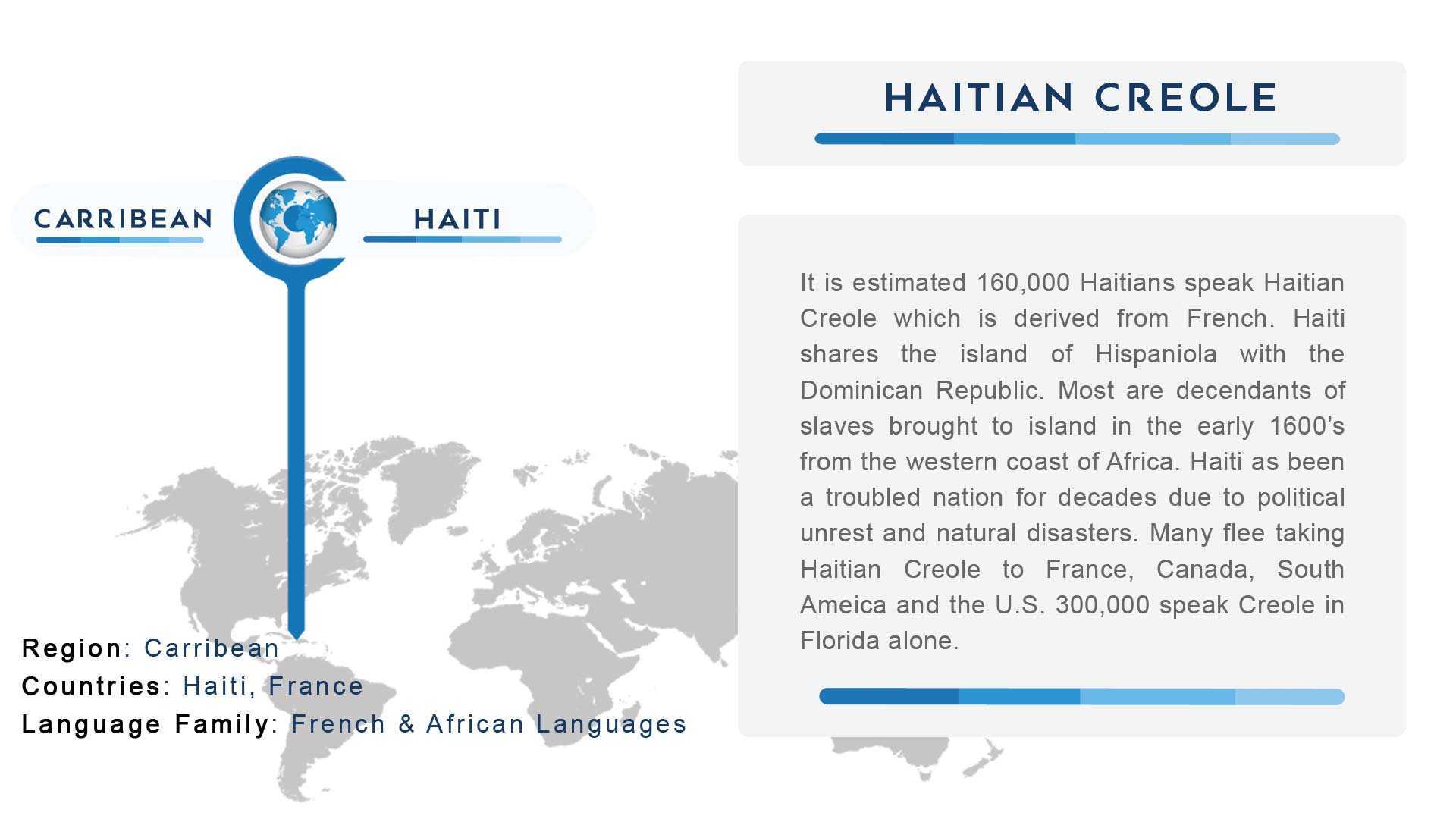Haitian Creole may be spoken as little as 2 percent in Haiti, that's all the more reason finding someone to translate your documents or provide interpreting from creole to English is difficult. If you're ready now, call us. We're open 7 days a week, all day — 24 hours, and we don't take off for holidays. You can reach us 365 days a year. Try us now, 888.737.9009.
CIT is here to offer Creole interpreters and translators with legal, medical and specialty experience, including criminal and civil matters, employee meetings, engineering, patent cases, labor disputes, immigration and more.
Although based in Los Angeles, CIT offers comprehensive Creole language services including interpretation, translation and transcription, 24 hours a day, 7 days a week, worldwide. Our interpreters and translators are native speakers who have been screened, certified, have provided credentials, field tested, and kept up to date with developments in both English and the Creole language through means such as lectures, conferences, and travel. CIT’s Creole language interpreters and translators possess in depth knowledge of the Creole language, as well as of the culture and history of the Creole people, allowing them to provide informed and complete interpretation and translation.

The word “creole” comes from the French applied to people who were living in the colonies, to differentiate between them and the European-born immigrants. There are several Creole languages and are based mainly on English, Portuguese, French and Spanish. Since there are several other creole languages, there are other languages based on Arabic, Hindi and Malay. The Creole languages are quite complex and have many grammatical rules.
More specifically, the French Creole language is spoken mainly in the Caribbean, the US and some islands in the Indian Ocean. Within the Caribbean, there are different types of Creole that are spoken. They are: Haitian, Guadeloupean, Louisiana, Guianese and Amapa Creole.
Historically speaking, Creole was often thought to be spoken by the lower class of European colonizers. Many believed their languages to be primitive and unsophisticated. However, there has been a big push for revival since the mid 1900s. More and more, the Creole languages are being used in education, government, business and media. There are even Creole languages that have become official languages for several countries. This includes Bislama (official languages of Vanuatu), Haitian Creole (Haiti), Tok Pisin (Papua New Guinea), Saotomense (Sao Tome Island), Kituba (Congo) and Sango (Central African Republic).
The Creole languages have many differences in sound, grammar and vocabulary. In Creole languages, there are small sounds, no consonant clusters and no tones. Creole grammar is much simpler than the languages that it is based on. There are no differentiations between number, gender and case markings. However, the personal pronouns system is quite complicated.
There is no copula or determiners. Vocabulary is rather restricted. Words in Creole can have various meanings from the languages they were borrowed. Wiring in Creole has been developed by missionaries who took orthographies of their own tradition to be implemented in Creole. The orthographic has several similarities to English, French, Spanish and Portuguese.
The term “Creole” also refers to New World products that came from Old World goods. It is often times applied to architecture, identity and food. It is usually referred to people born in Louisiana during French and Spanish occupations. When the Creoles settled, they tried their best to nourish the land and grow crops.
The Creoles have historically, and today as well, transcended all boundaries of race. Because of the many roots of their descendants, their heritage is mixed and may include African, French, Spanish and even Native American.
Should one be more interested in Creole culture, visiting the Cane River Creole National Historical Park’s Oakland and Magnolia Plantations will help to further understand Creole culture and learn about their past and what they are still continuing to do for their nation.
Many Haitians begin their journey to the United States many years before arriving in the U.S. They first arrive in Brazil making their way east before finally heading through Central America where many have become ex-pats in Guatemala.
In September of 2021, mass immigration to the U.S. took place by over 15,000 Haitians living in Guatemala and Mexico. Mexico stated they should return to Guatemala as thousands responded to President Biden's open border policy and dismantling President Trump's remain in Mexico border policy, most relocated to Florida.
The question of where would the Haitian foreign nationals go made national news for days as others have gone to Maryland Arizona, New York, and elsewhere. If you are a Haitian immigrant in need of document translation or an interpreter for immigration needs, call CIT 24 hours a day at our toll-free number, 888.737.9009. There is no charge for the call.


No matter what your needs may be, we can and are ready to assist you now. We have translators and interpreters standing by 24/7.

CIT's interpreter is such a rockstar, and it’s so great to have him as a lead interpreter for our Board meetings. About Our Interpreters 
Thank you for always being able to handle emergency interpreting assignments with ease. About Urgent Requests 
Thank you for always being able to handle emergency interpreting assignments with ease. About Urgent Requests 
Your translation rates are more competitive than other language service providers I used in the past. About Pricing 

Professionalism matters at CIT. We respond to request inside 24 hours.







